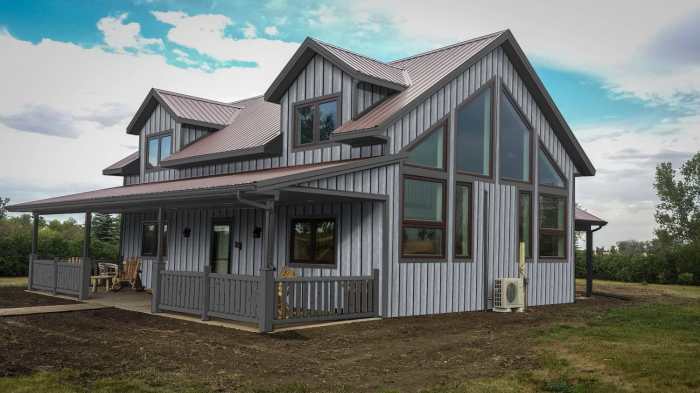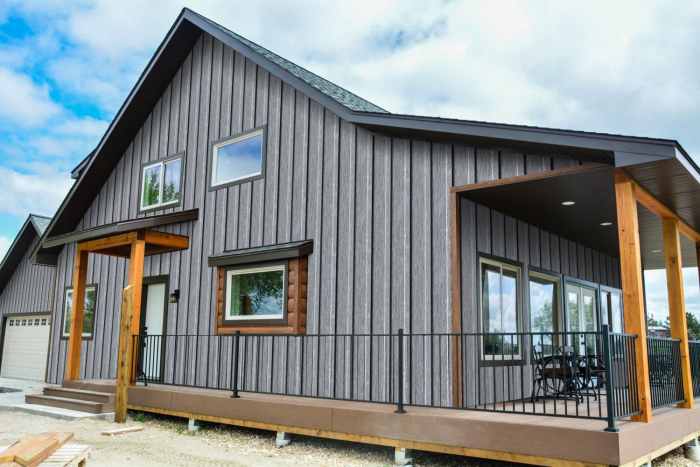As metal siding for houses takes center stage, this opening passage beckons readers into a world crafted with good knowledge, ensuring a reading experience that is both absorbing and distinctly original. Metal siding offers a unique blend of durability, cost-effectiveness, and low maintenance, making it a popular choice for homeowners looking to enhance both the aesthetics and functionality of their homes.
Benefits of Metal Siding

Metal siding offers numerous benefits that make it a popular choice for homeowners looking for a durable, cost-effective, and low-maintenance option for their houses.
Durability
Metal siding is known for its exceptional durability, outlasting other materials such as wood or vinyl. It can withstand harsh weather conditions, including heavy rain, snow, and strong winds, without deteriorating or warping. This longevity ensures that metal siding remains intact and looking great for many years to come.
Cost-Effectiveness
While metal siding may have a higher initial cost compared to other materials, its long-term cost-effectiveness is undeniable. Due to its durability and low maintenance requirements, homeowners save money on repairs and replacements over time. Additionally, metal siding can increase the energy efficiency of a home, leading to lower heating and cooling costs in the long run.
Low Maintenance
One of the most attractive features of metal siding is its minimal maintenance requirements. Unlike wood siding that needs frequent painting or staining, metal siding only requires occasional cleaning with water and mild detergent to maintain its appearance. This saves homeowners time and money on upkeep, allowing them to enjoy their homes without the hassle of constant maintenance.
Types of Metal Siding
Metal siding comes in various types, each offering unique features and benefits for houses. Here are some of the most common types of metal siding available in the market:
Steel Siding
Steel siding is a popular choice due to its durability and strength. It is available in a wide range of colors and styles, making it versatile for different architectural designs. Steel siding is also known for its low maintenance requirements, making it a practical choice for homeowners.
Aluminum Siding
Aluminum siding is lightweight and corrosion-resistant, making it a great option for coastal areas or regions with high humidity. It is also recyclable, making it an environmentally friendly choice. Aluminum siding can be easily painted to match the desired color scheme of the house.
Copper Siding
Copper siding is known for its luxurious and elegant look. Over time, copper develops a natural patina that adds character to the exterior of the house. While copper siding is more expensive than other metal options, it is extremely durable and can last for decades with proper maintenance.
Zinc Siding
Zinc siding is a modern and sleek option for metal siding. It is highly resistant to corrosion and requires minimal maintenance. Zinc siding is also environmentally friendly, as it is recyclable and energy-efficient. It develops a protective layer over time, giving it a unique weathered appearance.
Tin Siding
Tin siding is a traditional option that adds a rustic charm to houses. It is lightweight and easy to install, making it a cost-effective choice for homeowners. Tin siding can be painted or left unfinished for a weathered look, offering versatility in design options.
Installation Process
Installing metal siding on a house involves several key steps to ensure a successful and durable outcome. Proper preparation and attention to detail are essential throughout the process.
Preparation of House Exterior
Before beginning the installation of metal siding, it is crucial to prepare the house exterior properly. This includes:
- Clean the surface: Remove any dirt, debris, or old paint from the walls to ensure a smooth and clean surface for the siding to adhere to.
- Repair any damage: Address any cracks, holes, or rot in the walls before installing the metal siding to prevent further issues down the line.
- Apply a weather-resistant barrier: Install a weather-resistant barrier, such as house wrap, to protect the walls from moisture and improve insulation.
- Measure and plan: Take accurate measurements of the walls and plan the layout of the metal siding to ensure a precise and professional finish.
Common Challenges and Solutions
During the installation of metal siding, several common challenges may arise. Here are some tips to overcome them:
- Uneven walls: If the walls are not straight or even, use furring strips to create a level surface for the metal siding.
- Improper fastening: Ensure that the siding is properly fastened to the walls using appropriate nails or screws to prevent it from coming loose over time.
- Mismatched panels: Check the color and style of the metal siding panels before installation to avoid any inconsistencies in the finished look.
- Weather conditions: Avoid installing metal siding during extreme weather conditions, such as high winds or rain, to ensure a smooth and efficient installation process.
Maintenance and Care
Metal siding is a durable and long-lasting option for homes, but proper maintenance is essential to ensure it stays in top condition for years to come. Here is a guide on how to maintain and care for your metal siding effectively.
Cleaning Metal Siding
Regularly cleaning your metal siding is crucial to prevent dirt, grime, and other debris from building up and causing damage. Here are some steps to clean metal siding effectively:
- Start by rinsing the siding with a garden hose to remove loose debris.
- Mix a solution of mild detergent and water in a bucket.
- Use a soft-bristle brush or a cloth to scrub the siding gently with the soapy solution.
- Rinse the siding thoroughly with clean water to remove any soap residue.
- For stubborn stains, you can use a solution of vinegar and water or a specialized metal siding cleaner.
- Avoid using abrasive cleaners or tools that could scratch the surface of the metal.
Repairing Damage
Even with proper care, metal siding can sometimes get dented, scratched, or otherwise damaged. Here are some tips on repairing common issues with metal siding:
- For small dents, use a rubber mallet to gently tap the metal back into place.
- For scratches, you can touch up the paint with a matching color to prevent rust from forming.
- For more significant damage, such as large dents or deep scratches, it may be best to consult a professional for repairs.
- Regularly inspect your metal siding for any signs of damage and address them promptly to prevent further issues.
- Consider applying a protective coating or sealant to your metal siding to help prevent damage and extend its lifespan.
Last Word

In conclusion, metal siding for houses presents a compelling option for those seeking a durable, cost-effective, and visually appealing exterior solution. With proper installation, maintenance, and care, homeowners can enjoy the benefits of metal siding for years to come, ensuring their homes remain both beautiful and protected.
Q&A
How does the durability of metal siding compare to other materials?
Metal siding is highly durable, outlasting many other materials such as wood or vinyl, and requires minimal upkeep to maintain its longevity.
What are the common challenges faced during metal siding installation?
Some common challenges include ensuring proper insulation, addressing any structural issues in the house, and dealing with weather-related obstacles during installation.
How can I maintain metal siding to prolong its lifespan?
Regular cleaning, inspection for damage, and timely repairs are key to maintaining metal siding and ensuring it lasts for years to come.














